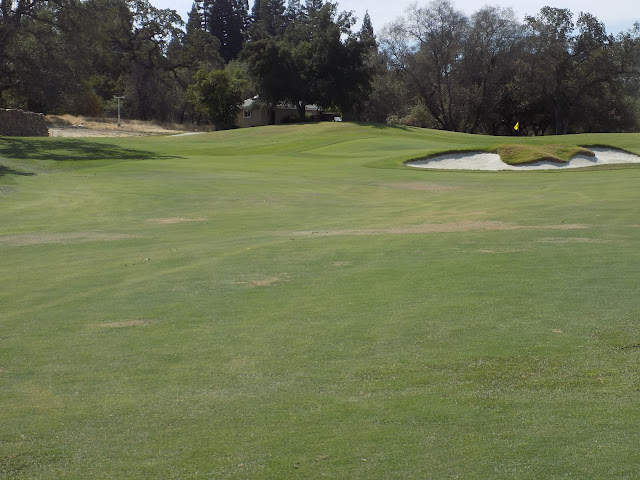Recently we have had to put out signs to remind some of our Members about their responsibility of repairing ball marks on greens. I know the very active segment of our golf membership are passionate about repairing ball marks and educating those who are not as passionate, and it is time that the message comes from golf course maintenance as well. Your golf course maintenance staff is limited in what we can do with ball mark repair ahead of mowing greens in the morning. We start at 4:30 AM and work with vehicle lights and headlamps for the first few hours of our day as it is dark. Once a mower runs over a elevated ball mark, or even a slightly elevated pitch mark, the scalped turf will die and will need to recover from creeping grass around the scar or be repaired with sod or sand.
The most effective & successful repair of a ball mark or a pitch mark depression is the proper repair made immediately after the ball mark was made.
Our greens have matured substantially since October but they are still young and developing root mass and depth. And it's their first summer after their initial planting, so we are not taking any chances with them. This means at times they might be wetter and softer then they will be in the future and these conditions lend to deeper ball marks, although very evident and should be repaired by the golfer.
We repair massive ball marks every morning that had to have been visible the day or evening before to the Member Golfer that created it. Below are examples of what we come across on a regular basis as we prepare the greens for daily play.
 |
Very visible ball mark prior to GCM repair. Monday AM ahead of brushing in topdressing sand. |
 |
Another evident ball mark prior to GCM repair on Monday AM as well |
 |
This is not a ball mark, but a divot taken out of #2 green sometime on Sunday 8/7/22. |
 |
None of us are fans of signs on our Private Golf Club as it is implied that with the privilege's of being a Member of Granite Bay Golf Club comes responsibility of basic golf course care. That being said, I agree with the Golf Committee that we need to do something and try to get everyone on the same page.
|
1. The proper technique for ball mark repair is easy and fast.
Insert the ball mark repair tool behind the ball mark and gently pull the top of the tool toward the center. Continue working around the ball mark, pulling the surrounding turf in toward the center of the indentation. Avoid using a lifting or twisting motion because this can damage turf roots. Once you have finished pulling turf in toward the center, gently tamp the area down with your putter to create a smooth, firm surface
2. Unrepaired ball marks cause lasting problems
Failing to repair a ball mark may seem like a minor oversight, but there are lasting consequences. Unrepaired ball marks can take weeks to heal, during which time they can cause balls to bounce off line. The damage to the putting surface is also an entry point for weeds that can cause serious problems.
3. Certain putting greens are more vulnerable to ball marks than others.
Any putting green that typically receives high, lofted approach shots will be more susceptible to ball marks. The putting greens on par-3 holes are a perfect example. If you recognize that a putting green is prone to damage from ball marks, it is important to be mindful of repairing your own ball mark and a few unrepaired ones nearby.
4. Soft conditions mean more ball marks.
When putting greens are wet or soft, ball marks will be more of an issue. This is just one of the reasons why superintendents work hard to promote firm playing conditions with aeration, topdressing and other maintenance practices. If excessive thatch accumulates beneath the putting surface, ball marks and other turf issues will be more problematic.
5. Almost any pointed tool can be used to successfully repair a ball mark.
Many different tools have been created to repair ball marks, including single-pronged and fork-shaped tools. Almost any pointed tool, including a golf tee, can be used to effectively repair a ball mark. Using the proper technique is the key to success.
 |
Traditional ball mark repair tool that I like using when repairing ball marks and pitch marks. The tool is beside a ball mark that is recovering as grass is moving into middle but who knows how long that repair process has taken. |
I understand that most Members who read these Course Updates repair both their own and other ball marks constantly and I thank you for your care as well as your continued efforts to educate fellow Members.
Progress on this front will need to be collaborative effort, so we will step up our efforts in GCM to catch the errant mark that escaped the responsible party before mowing, and of course our continued mission is to work on maturing and firming these greens. Firmer greens will not necessarily make ball marks a thing of the past, but will help, although it will take time. At the end of the day, the responsible party for the ball mark or pitch mark is the golfer who made them. The best quote from the
USGA Article is:
"Repairing ball marks is one of the easiest ways that golfers can help superintendents deliver high-quality playing conditions. After hitting a great shot onto the putting green, fixing your ball mark and a couple nearby is an excellent way to celebrate".
Thank You for your Help!





















